Sep 3, 2024
The Power Of Habit
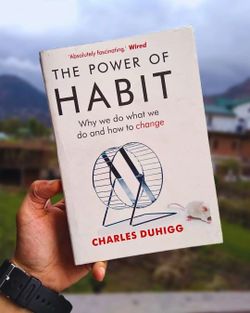
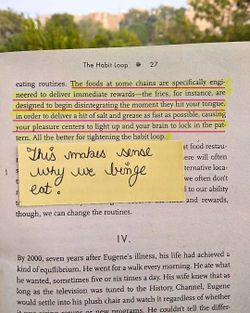
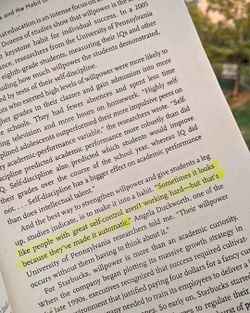
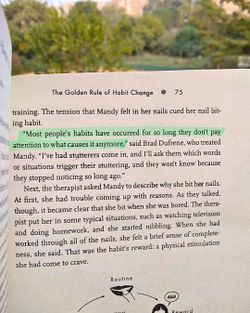
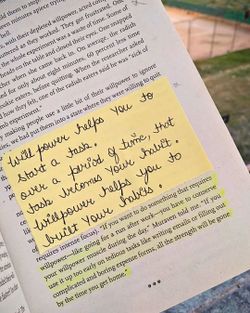
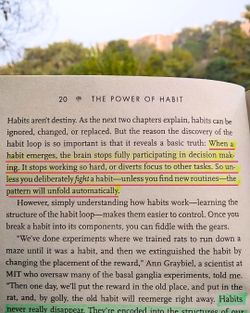
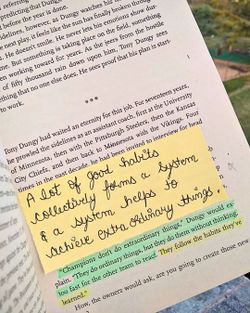
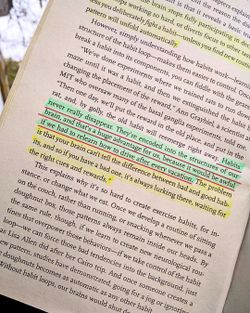
Chapter 1 Habit loop
cue, routine, reward
Habits are super-important – they let our brains save energy and size for other things
Eugene could function almost normally without a memory due to his habits
He could also build new habits over time
Habits are also delicate – if the cue isn’t there, they won’t trigger
Habits don’t leave us; once they’re ingrained, they stay under the surface waiting for cues to trigger them. It’s work to avoid running those routines if a cue happens.
McDonald’s fries are designed to melt immediately, in order to give the reward right away and tighten the habit loop
The store designs and everything else are as standardized as possible in order to keep cues consistent and trigger routines
Squire’s paper on Eugene’s habits was the spark that really ignited habit research
Habits are bound up in the basil ganglia, one of the most ancient and central parts of the brain
Brain activity is much lower when executing the routine part of the habit loop
“Chunking” – the brain’s process of converting a sequence of actions into an automatic routine
Chapter 2 Claude C. Hopkins – successful ad man who helped make Pepsodent successful
Turns out Pepsodent’s success was mainly due to the tingly feeling in the mouth due to the ingredients
Habit loops eventually form a craving – the anticipation of the reward
Hopkins thought it was the reward of clean teeth that drove the habit loop
It’s actually confirmation of the product “working”
Febreze is a similar story
The success is in the reward of a cleaning job well done
Febreze was originally odorless and marketed as a way to get rid of bad smells
Now it’s the fresh, clean smell that accompanies the end of a cleaning session
Julio the monkey
Got blackberry juice from pulling a lever when a shape showed up on a screen
Brain activity at first – level, but a spike when the reward showed up
“I got a reward!”
Eventually, as the habit loop solidified, the brain activity spiked right after the shape showed up
The anticipation of the reward caused the activity spike
Craving – it’s really powerful. Made the monkeys ignore distractions
Craving is why we find it so hard to ignore notifications – a craving for distraction
Exercisers crave the “good feeling” after a workout, or a specific reward, or are envisioning a result
Shampoo doesn’t have to foam and toothpaste doesn’t need to feel tingly to work – but those components fill the craving fr validation of effectiveness
Chapter 3
Claude Hopkins created a new habit with Pepsodent – but old habits can’t be destroyed. Rather, they must be replaced.
The Golden Rule of habit change:
Keep the same cues and rewards, but replace the routine.
Smokers have a cigarette cue and a rush reward – replacements for the routine can include nicotine gum, caffeine, or other things
This can be used for small behavioral tics – such as nail biting – as well as large problems like addiction
Replacing the routine is not effective on its own when stressful situations arise in people’s lives. Then, belief is the key addition.
AA uses a belief in God as one of its central tenants
Researchers find it’s not necessarily a belief in God, but rather a belief in something greater than one’s self
Having support groups is a huge boon to habit change
Coach Dungy found that drilling habits into his players – first on the Bucs, then the Colts, made them faster and less likely to hesitate by trying to think during plays
Most coaches at that time relied on hugely complex playbooks with feints and counterfeints
Dungy focused on a few plays, drilled into automatic habits
Dungy’s habit changes weren’t enough in high-pressure games (conference championship) because the pressure caused players to fall back into their old routines
Not until Dungy’s son committed suicide did the change happen
The players rallied around Dungy in his tragedy and started to believe in what he had taught them
They then won the Super Bowl
Chapter 4
Paul O’Neill used worker safety as a keystone habit at Alcoa in order to improve almost every aspect of the business
All parties involved – execs, employees, union – could get behind safety. Nobody would fight him on it.
Improving safety naturally improved efficiency
Organizations runs on habits more often than they run on logic
The VA would build hospitals even when they weren’t needed
The cue was budget money. Routine was to build a hospital. Reward was the politician being able to point and say “look what I did!” to climb the ladder of success
“Individuals have habits, organizations have routines”
O’Neill used habits to encourage change at all levels
Managers were required to report any and all safety issues. The only way to get promoted was to be a person that did this.
This created a success-driven habit loop that improved safety
Keystone habits work in weight loss as well
Old way was to try enacting radical change to help obese people lose weight – but it fails
What ended up working? Asking people to keep a food diary once a week
Some people kept daily journals, then started noticing patterns they didn’t know existed.
From there, they took steps to change the patterns, and that blossomed into even more good habits
Keystone habits create “small wins” which help other habits flourish by creating new structures.
They create culture where change is contagious
Michael Phelps keystone habit was “the videotape” – a visualization of every part of a race in his head, which helped keep him calm and focused
“Small wins are a steady application of a small advantage.” – Cornell professor in 1984
O’Neill helped to lower infant mortality rate before going to Alcoa
Mortality -> malnutrition of mothers -> malnutrition before becoming pregnant -> lack of biology knowledge -> teachers weren’t trained in biology and nutrition
Gov’t revamped teacher education in college to add in biology teaching. Infant mortality has gone down 68%
Chapter 5
Travis had parents who were functional drug addicts
Had trouble controlling his anger and couldn’t hold down jobs
Got a job at Starbucks and completely turned life around
Starbucks has an education focused on increasing its employees’ willpower
2005 study analyzed 164 8th-graders
students with high willpower got higher grades and better selection in colleges
Willpower more important than IQ or other factors
“Self-discipline predicted academic performance more robustly than did IQ. Self-discipline also predicted which students would improve their grades over the course of the school year, whereas IQ did not…”
Marshmallow study – children who could resist the marshmallow to get double treats later were more successful as adults
SAT scores 210 higher on average
More popular, did fewer drugs
Willpower can become an automatic habit
It’s also depletable
Muraven’s study of a bowl of cookies and bowl of radishes
Those who had to eat the radishes spent much less time on a puzzle that was actually impossible. They became irritated more easily.
“Willpower isn’t just a skill. It’s a muscle, like the muscles in your arms or legs, and it gets tired as it works harder, so there’s less power left over for other things.”
Australian 2006 study – building willpower in one area (working out or money management) spilled over into other areas
This is a more important reason for signing kids up for soccer or piano. The practice builds the willpower muscle for other things
1992 – British psychologist worked with a group of lower-income elderly people who all had knee or hip replacements
The recovery from the surgery is very painful – moving hurts a lot, but exercise must be started almost immediately so flexibility can be retained
Study’s participants were given a document that included additional pages where they could write down specific action steps and goals for a certain week
People who wrote plans started walking almost twice as fast and getting out of chairs 3 times as fast
The patients who wrote plans would write out very mundane details – but this meant they were anticipating the moments of pain and planning for them in advance
Their plans were build around inflection points and how they would deal with them.
“The patients were telling themselves how they would make it over the hump.”
Starbucks eventually incorporated this idea into their training programs. Now they have employees write out plans for how to deal with stressful situations
LATTE – listen, acknowledge problem, take action to solve it, thank them, explain why it happened
This is how willpower becomes a habit – by choosing a certain behavior ahead of time and following a planned routine when an inflection point arrives
Another incredibly important aspect is autonomy. Much of willpower comes from the feeling that you are in control of your life.
Two groups were told to ignore cookies in Mark Muraven’s research.
1 group was told very politely, and told they could suggest changes to make the study better
Other group was simply told “You must not eat the cookies.”
No one ate the cookies, but people who were told impolitely were much worse at hitting a space bar when a 6 flashed on a screen followed by a 4.
The group who was treated well felt they had a sense of control over the experience, so their willpower muscle wasn’t depleted as fast
2010 study – manufacturing plant in Ohio let employees design their uniforms and control scheduling – 20% increase in productivity within 2 months. Nothing else was changed.
Chapter 6
Organizational habits need to form a truce between different parties to be effective
Rhode Island Hospital nurses had no power or equal footing with doctors
Doctor arrogance, and nurse inability to say anything or stop procedures, caused many surgeries where the wrong side was operated on. One 86-year-old man died.
The hospital’s habits were not organized around a keystone – they had just emerged naturally among the workforce
An Evolutionary Theory of Economic Change – published in 1982 by Nelson and Winter – was incredibly successful in the business world
“Much of firm behavior is best understood as a reflection of general habits and strategic orientations coming from the firm’s past rather than the result of a detailed survey of the remote twigs of the decision tree.”
Basically, it may seem like organizations make rational choices based on deliberate decision making, but that’s not true. Rather, organizational habits drive firms, and they emerge from thousands of independent employee decisions.
These organizational habits are called “routines” by N&W, and are vital to getting anything done
Workers don’t have to ask for permission on every single thing
Companies are battlefields of a civil war. Department heads, individual employees, etc all compete for prestige and power, and operate partly on fear. Self-interest plays into everything.
However, most companies operate peacefully due to truces.
It’s basic game theory. Sacrifice a bit of your self-interest to keep things running smoothly.
Try to bolster your own department instead of sabotaging others. Otherwise everyone will gang up on you.
If every salesperson offered huge discounts, the company would tank. So they compromise to limit discounts, even though each individual salesperson would like to give tons of them to rack up sales for themselves.
Rhode Island Hospital didn’t have a good truce because nurses had no power.
King’s Cross station fire
Totally preventable, but so many habits had emerged to keep everyone focused only on their department and not “stepping on toes.”
Nobody was actually in charge of keeping people safe
The fire wasn’t reported until too late and 31 people died
A crisis (or perceived crisis) can be the event that gets previously stubborn people to change. A crisis can help people to see that certain things need a re-balancing of power in order for safety or other crucial things to be taken care of.
Rhode Island Hospital’s media frenzy was the crisis that the administration was able to use to enact change. Now, nurses are empowered and the hospital is very safe.
Desmond Fennel was assigned to investigate the King’s Cross fire. So many department heads wouldn’t budge on proposed changes, so he created a media frenzy out of it as well. It worked – the leadership was fired, new laws were passed, and now King’s Cross has much better safety procedures.
“You never want a serious crisis to go to waste.” – Rahm Emanuel, Obama’s chief of staff 2008
Chapter 7
Andrew Pole – data expert for Target
Target wanted to target soon-to-be moms
Pregnant women are a gold mine for retailers – they can sell baby things, but also everything else
Tired parents who buy baby stuff at Target would buy everything else there as well because it’s easy
That would breed loyalty as well
Target has massive data collection capabilities – they tie all data to a Guest ID so they know what people by, why, and what they can do with that data
Before using analytics, companies would use sorta-scientific psychology tactics designed to exploit subconscious mind when shopping
Produce is first in a store because you put it in your cart, feel good, and are then more likely to justify buying more profitable junk food
However, shoppers have individual habits – so those tricks only go so far. Hence the data collection and analysis
“Consumers sometimes act like creatures of habit, automatically repeating past behavior with little regard to current goals.” – USC 2009 psychologists
Each person’s habits are different though
1984 – UCLA professor Alan Andreasen wanted to know why people suddenly change buying habits
Surveyed hundreds of consumers in LA
People changed buying habits when they went through a major life event
Married -> buy new type of coffee
Divorced -> buy new type of beer
New house -> new type of cereal
Having a baby is pretty much the biggest major life event, so habits are very malleable then
Target realized that revealing that they know a woman is pregnant would seem creepy, and they’d face backlash for it
Example: The dad who was furious about the baby item coupons his high school daughter received. Later, he apologized when he found out she really was pregnant
Target’s solution: Mixing the baby item ads in with completely unrelated ads to make the coupons seem random and not targeted
People don’t like the feeling that they’re being spied on. They also don’t like huge changes
When “Hey Ya” came out, record execs and computerized song analyzer programs like Hit Song Science predicted it would be a huge hit
However, radio listeners hated it according to the data. A lot of them tuned out within 30 seconds of the song coming on
Rich Meyer had analyzed thousands of songs that were “sticky” – that kept people tuned in
Many of them were very bland or featureless
However, they all had something in common – they were all “what you’d expect” of that genre
In other words, they were familiar
People didn’t like “Hey Ya” because it was so unfamiliar
To fix this, DJ’s would sandwich “Hey Ya” in between two familiar, sticky hits. It worked.
U.S. government did this too – because so much meat was going overseas in WWII, Americans needed to eat organ meats. But they didn’t want to
The government launched a campaign to educate housewives on how to disguise these meats as familiar dishes. By the 1950’s, offal food was a staple.
This is why Target made their ads look random. People were familiar with that type of advertising
YMCA learned the same thing – people were actually looking for things explained by familiar human drives, such as friendship. So instead of focusing too much on new gym equipment, they focused on group fitness and trained employees to learn customers’ names.
Chapter 8
Rosa Parks’ arrest on the Montgomery bus was a catalyst for making the civil rights movement successful. The subsequent bus boycott that happened was successful because movements are carried by three things
Strong ties – friendships between individuals – start the movement
Weak ties – casual relationships that cause social pressure – grow it
Habits are created that give participants a new sense of identity – which helps the movement endure
Most bus arrests caused no stir, but Rosa’s did because she had friendships across all social circles. She was involved in a ton of different clubs and activities
Most of us have friends that are similar to us – look similar, make a similar amount of money, etc.
Rosa’s relationships really spanned social circles of all types
The boycott didn’t die immediately because of weak ties.
If you’re an executive and are asked to recommend a good friend, it’s a no brainer. You do it. Same for someone you don’t know at all – it’s a no brainer that you shouldn’t
But if they’re a casual acquaintance, you probably will recommend them because you want to be seen as a team player and not lose social standing.
Mark Granovetter – Harvard PhD in the 60’s – studied how 282 men got their jobs. Many of them got their jobs through weak-tie recommendations
These ties are more important than strong ties in getting a job because they give us access to other social circles we normally couldn’t get into
Granovetter: “Individuals with few weak ties will be deprived of information from distant parts of the social system and will be confined to the provincial news and views of their close friends. This deprivation will not only insulate them from the latest ideas and fashions but may put them in a disadvantaged position in the labor market, where advancement can depend… on knowing about appropriate job openings at just the right time.
Weak ties help spread a movement beyond the initial clique. They help create peer pressure, which is very influential in getting people to do hard or inconvenient things. They’d rather do them than risk losing social standing
That’s why people who were religious and associated with a church group all participated in Summer of Freedom, even though they faced potential violence
People in social groups where that service expectation wasn’t part of the social fabric didn’t feel the pressure – so many dropped out after applying
“On the playground, peer pressure is dangerous. IN adult life, it’s how business gets done and communities self-organize.”
Rick Warren used habits to build Saddleback Church into the mega church it is today.
At first, he was working himself to death. His church was initially successful because it addressed problems people had with regular church – bad music, boredom, dressing up, etc – but he was expending far too much effort
He used the writings of Donald McGavran to build habits for his parishioners – who emphasized Christianizing people in a manner that didn’t take them out of their normal social relationships.
After Warren returned from his absence, he had people form small groups in living rooms to gather each week, taking work off his plate. He then educated people to create habits that would strengthen their faith and create a new sense of identity. This made his movement self-propelling, which ensured its lasting success.
Chapter 9
Angie Bachmann (not real name) was a bored housewife
Went to the casino one day to relieve the boredom, eventually turned it into a manageable habits once or twice a week
Soon it became more often as she became a “good gambler”
By 2001 she was at the casino every day
She wanted to feel good at something
The pain of losing passed so quickly
Summer of 2001 – gambling debt totaled over $20k
Even after the intervention, the gambling didn’t end
Brian Thomas strangled his wife to death while they camped in a van
There had been people racing around the parking lot where they parked
In his subconscious state, Brian thought an attacker was on his wife. He thought he was strangling the attacker.
In reality, he strangled his wife
Brian suffered a sleep terror – like sleepwalking, but much more powerful. Inconsolable
Sleepwalking happens when the brain doesn’t make “the switch” – putting the body into sleep paralysis before going into dream state
Sleep terror brain activity is different than awake, sleeping, or even sleepwalking
Brain shuts down except for most primitive neurological regions (“central pattern generators”), so base instincts take over
Automatic behaviors are acted upon with no control from higher regions of brain
Fight or flight response – the response will be carried out, even if it’s murder. The brain isn’t aware what’s even happening
It’s automatically following the habit loop
The jury and even prosecution decided that Brian was not a murderer. He had no idea of what he was doing, and wasn’t even aware that something of this nature might happen. Sleepwalking isn’t indicative of sleep terror
Angie Bachmann’s life took some bad turns – her parents died, her relationship with her family was deteriorating, etc
At the same time, Harrah’s Entertainment would pressure her to come gamble
Eventually, it became a habit. Even though she didn’t want to, she’d give in and go gamble to get that quick reward. Eventually, she lost $250,000 in one night
She eventually gambled away all the family’s money and their house
Habitual gamblers have different brain activity than normal gamblers
When a near miss happens, a normal gambler sees it for what it is: Still a loss
Habitual gamblers see it as a win, neurologically. They get the same excitement – and they keep gambling
Due to this, all slot machines are now programmed to show way more near misses
When Bachmann was sued, she used the same defense that Brian used. However, they ruled against her.
The difference was that she was aware of her habits, and didn’t take steps to mitigate them enough
To modify a habit, you must decide to change it. There must be a conscious decision
The point of the book: Once you understand that habits can change, you have the freedom and the responsibility to change them.
“Some thinkers hold that it is by nature that people become good, others that it is by habit, and other that it is by instruction.” – Aristotle, Nicomachean Ethics – Aristotle believed habits were key
“Just as a piece of land has to be prepared beforehand if it is to nourish the seed, so the mind of the pupil has to be prepared in its habits if it is to enjoy and dislike the right things.”
“All our life, so far as it has definite form, is but a mass of habits – practical, emotional, and intellectual – systematically organized for our weal or woe, and bearing us irresistibly toward our destiny, whatever the latter may be.” – William James
James practiced affirming that he had control in his diary every day – and he went from a failure to massively successful. His “one year experiment” worked.
Habits are like water – to a fish, water isn’t noticed. To us, most of our habits aren’t either. We must deliberately notice them.
Water hollows out a channel and flows through it. If its flow is stopped, it’ll flow the same way when it starts again. Habits are similar
James – The Principles of Psychology – chapter on habits
Afterword
No matter how strong our willpower, we will occasionally fall back on bad habits. It’s important not to make the “second mistake” (as James Clear would say) or commit the “What the Hell” effect – leave these slip-ups as slip-ups. Outliers.
Smokers often fail 7 times or more before finally quitting for good
This isn’t really failure – it’s experimentation.
They learn more about themselves, where the cues actually lie, and what new habits provide good rewards
For Eric, that habit was meditation
“That’s why failure is so valuable. It forces us to learn, even if we don’t want to.”
Procrastination studies – people’s willpower often fails after a while, and then they’re back to Facebook
The key is to pay attention to how resolve eventually fades
Don’t ignore it
Learn when you feel the urge to check Facebook or another website
But limit that break to 10 minutes
You’re planning for pressure-released moments ahead of time – just like the knee-replacement patients planned for the painful points ahead of time
(You could use an extension to actually limit FB time to be more successful with this)
Appendix
Formulas do exist for changing habits – but doing so is still hard because habits and individuals are all different. However, change can be made with effort.
Framework for changing habits:
Identify the routine
Easiest part: What is it that you do?
Many days, I pack up, walk to Milo, and spend $13 on lunch and coffee I don’t need
Now, ask questions – what’s the cue, and what’s the reward?
Experiment with rewards
The reward might not be obvious. It might not just be satisfying hunger
What are you craving? To find out, experiment with different rewards
At first, think of yourself as a scientist collecting data. Don’t think of failures as true failures yet
After getting the reward, write down the first thing on your mind afterwards
Studies show this helps in remembering what you were thinking at the time later on
Also, set a 15-minute alarm after you get the new reward. When it goes off, ask yourself if you still feel the urge for the old routine
If you do, you know the new reward isn’t what you were craving
Isolate the cue
Researcher at University of Western Ontario wanted to find out why people sometimes misremember details from crimes
After carefully narrowing down what she paid attention to, she figured out it was when cops seemed friendly – this triggered a “desire to please” habit that caused people to remember what they thought the cop wanted to hear rather than true facts
Only by narrowing her observation could she find this
Isolating cues is the same
Experiments show that cues fall into 5 categories
Location
Time
Emotional State
Other people
Immediately preceding action
Try writing down the details for each category when the craving for a habit strikes. Then, after a while, look for patterns to isolate the cue
Have a plan
Re-engineer the habit loop so that you’re making choices again.
Take the data you have a write down a deliberate choice that you’ll make when the craving strikes
By undefined
19 notes ・ 41 views
English
Upper Intermediate